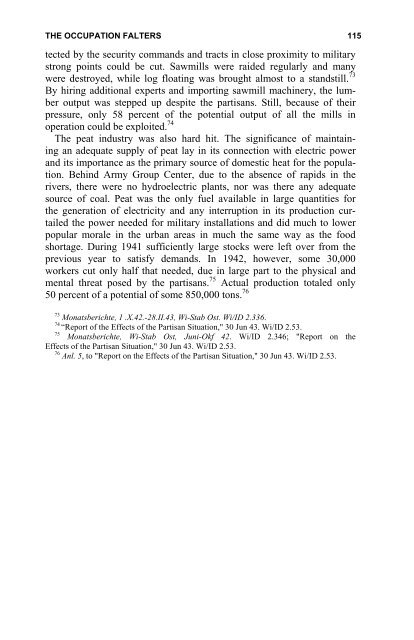the soviet partisan movement 1941-1944 by edgar m. howell
the soviet partisan movement 1941-1944 by edgar m. howell
the soviet partisan movement 1941-1944 by edgar m. howell
Create successful ePaper yourself
Turn your PDF publications into a flip-book with our unique Google optimized e-Paper software.
THE OCCUPATION FALTERS 115<br />
tected <strong>by</strong> <strong>the</strong> security commands and tracts in close proximity to military<br />
strong points could be cut. Sawmills were raided regularly and many<br />
were destroyed, while log floating was brought almost to a standstill. 73<br />
By hiring additional experts and importing sawmill machinery, <strong>the</strong> lumber<br />
output was stepped up despite <strong>the</strong> <strong>partisan</strong>s. Still, because of <strong>the</strong>ir<br />
pressure, only 58 percent of <strong>the</strong> potential output of all <strong>the</strong> mills in<br />
operation could be exploited. 74<br />
The peat industry was also hard hit. The significance of maintaining<br />
an adequate supply of peat lay in its connection with electric power<br />
and its importance as <strong>the</strong> primary source of domestic heat for <strong>the</strong> population.<br />
Behind Army Group Center, due to <strong>the</strong> absence of rapids in <strong>the</strong><br />
rivers, <strong>the</strong>re were no hydroelectric plants, nor was <strong>the</strong>re any adequate<br />
source of coal. Peat was <strong>the</strong> only fuel available in large quantities for<br />
<strong>the</strong> generation of electricity and any interruption in its production curtailed<br />
<strong>the</strong> power needed for military installations and did much to lower<br />
popular morale in <strong>the</strong> urban areas in much <strong>the</strong> same way as <strong>the</strong> food<br />
shortage. During <strong>1941</strong> sufficiently large stocks were left over from <strong>the</strong><br />
previous year to satisfy demands. In 1942, however, some 30,000<br />
workers cut only half that needed, due in large part to <strong>the</strong> physical and<br />
mental threat posed <strong>by</strong> <strong>the</strong> <strong>partisan</strong>s. 75 Actual production totaled only<br />
50 percent of a potential of some 850,000 tons. 76<br />
73 Monatsberichte, 1 .X.42.-28.II.43, Wi-Stab Ost. Wi/ID 2.336.<br />
74<br />
“Report of <strong>the</strong> Effects of <strong>the</strong> Partisan Situation," 30 Jun 43. Wi/ID 2.53.<br />
75<br />
Monatsberichte, Wi-Stab Ost, Juni-Okf 42. Wi/ID 2.346; "Report on <strong>the</strong><br />
Effects of <strong>the</strong> Partisan Situation," 30 Jun 43. Wi/ID 2.53.<br />
76<br />
Anl. 5, to "Report on <strong>the</strong> Effects of <strong>the</strong> Partisan Situation," 30 Jun 43. Wi/ID 2.53.
















